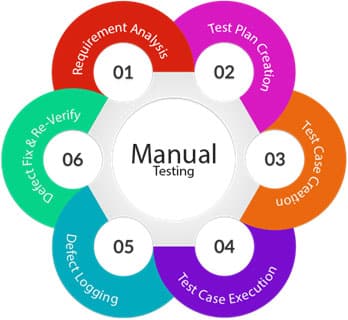Why Manual Testing Services Are Recommended over Automated Software Testing?

While testing software, a testing company can choose Automated as well as Manual testing methods. But, it entirely relies upon the softwares requirements, the budget of the project, and which testing method will be beneficial for the project.
QA designers and IT organizations are regularly asked by the clients when testing a software application – whether to select manual software testing alternatives or give an attempt to new automated systems.
There are some cases, in which automation testing rules but at the same time, it could end up costing you more than it’s worth. This is the reason because of which you must consider the expenses and advantages according to the project.
Manual Testing
Manual testing is a process of testing each and every program individually and making the comparison of the outcomes with that of expectations. Manual testing is a procedure in which tester utilizes the program as a user and encounters functionality to check whether every one of the features is working appropriately or not.
The procedure of QA testing can be a tedious task as you have to choose each setting inside a product package. Take an example, you have an application and you require to test it for 170 countries.
This implies you have to guarantee each of the countries lines up with the app currency. For manual QA testing, you have to choose a country and see the currency it is showing. In case there are constrained choices, it will make the task more manageable to physically or manually test the report.
It is always advisable to go for manual testing services if your task needs the human touch like the ease of use. Organizations having restricted expertise in the range are additionally suggested to begin with manual testing. Once the team of testers obtains mastering in the testing, they can later move toward automation.
Pros of Manual Testing
- The human component: While testing the product manually, you will get the exact kind of feedback a person would give you, and that can be very important. A computer or automated program can-not give you feedback about what your users will like or dislike.
- Cost-Efficient in case of short-term projects: Buying a software automation tool specifically for a short-term project gets expensive. Project costs largely depends upon Automation testers, frameworks, tools, and maintenance. All these factors add up to increased project costs. Automating a short term project or for a minor change makes no sense. In such kinds of projects, Manual Tests become more cost efficient and would add equal value as automation might do. Manual testing saves you from putting the same up-front costs into the software.
- Adaptable, on-the-fly testing: Testing expects you to compose, program, and review test cases for your product. But, in the event that you truly just need to test one little change, you can physically test it without requiring any tool or anything else.
- Manual testing is flexible: When one of those splendid thoughts comes to you, something that could change the course of the project, you need to have the capacity to take a shot at it promptly. With automation testing, it is difficult. You need to set up test cases, program it into the automated tool, and after that run the tests. With manual testing, you can just rapidly test and see the outcomes. Automatic tests take more time to set up, which doesn’t allow you to test ideas quickly and easily.
Automated Testing
Various tools are utilized by testers in order to execute automated testing. Automated testing is a process in which the tests of a software application are pre-scripted and the software tools execute these pre-scripted tests before it is released into production. It makes use of automation tools to write and execute test cases. Therefore, no manual involvement is required while executing an automated test suite.
If the expected and actual output is same, your program is working well; this implies your project is bug free. If the output doesn’t match the expectation, you need to investigate once again and keep on running tests until results match.
[Worth Read: How To Select The Test Management Tool For Manual And Automated Testing?]
Automation works best for Regression testing where the huge number of test cases are needed to be re-executed again and again. The biggest advantage you can get from automation testing is the speedier and effective output.
Automated Testing Pros
- Efficient Testing: Test automation makes the testing process extremely efficient. Experienced testers can be deployed to deal with the tricky or case specific tests while the automation software handles the repetitive, time consuming tests that every software has to go through. This not only saves up on time, money and resources, but also generates high ROI.
- Utilize the speed and productivity of PCs: Scripts are speedier than people, so you’ll accomplish more in less time.
- Reusable tests for code that gets frequent updates: If you always keep making updates, you don’t need to change test script each time, you can reuse them in your regression testing.
- Running tests 24/7: Regardless of where you are on the world. You can begin the tests when you leave the workplace and when you get back in the morning you can see the results and you can keep on working. You can even do that remotely in the event that you don’t have a great deal of gadgets or you don’t have the possibility to buy them.
Which type of testing is preferred?
The sort of testing (manual or automated) that is needed to be done on a particular project depends on various factors, and these are:
- Project requirements
- Deadline
- Suitability
- Budget
- Expertise
The vital factors demanded by any project are time, cost, and quality. With regards to testing, either manual or automated kind of testing may obtain great outcomes than the other.
Above factors greatly help to decide what type of testing is required and when it is required. Practical approach: When a new project comes, size, time period, resources required, testing frequency, code changes are some of the factors taken under consideration. For Example, there was an e-commerce application whose project size was large and time period for testing phase was very less. Also, the test scenarios were needed to be executed on regular basis because code changes were made frequently in the project. Being an e-commerce application, the traffic to the website was estimated to be very large. Therefore, Load, Volume, Stress and Capacity testing was performed on the web application. So, after considering all these points it was decided that Automation testing was apt for that particular application in order to deliver it on time.
Another example, there was a small scale project whose scope was limited as there were no further updations to the application. Being an educational application, maintaining attendance records and data records was the only motive of the application. The project completed in a month and there were no further changes to the application. So, writing test scripts and setting up the whole automation process could have wasted a lot of time and efforts. Therefore, we opted for Manual testing for that specific application.
Many experts recommend manual testing services for they are less expensive and include human observations. In the meantime, others recommend the extensive use of automated testing for the purpose of regression testing. At times, Regression tests are extremely tedious and time consuming so here automated testing comes in to play a major role. Both the testing approaches have their own advantages and appropriateness. It altogether relies upon the budget, duration, and type of project.
Written by: Claire Mackerras, a Senior QA Engineer & Editor associated with Bugraptors. A CMMi5 certified company with extensive experience as a third party testing vendor in US. She is passionate toward writing on technological trends for manual & automation software testing. She likes to share her knowledge, for the readers who are interested in exploring testing tact’s and trends.
Add CEOWORLD magazine to your Google News feed.
Follow CEOWORLD magazine headlines on: Google News, LinkedIn, Twitter, and Facebook.
This report/news/ranking/statistics has been prepared only for general guidance on matters of interest and does not constitute professional advice. You should not act upon the information contained in this publication without obtaining specific professional advice. No representation or warranty (express or implied) is given as to the accuracy or completeness of the information contained in this publication, and, to the extent permitted by law, CEOWORLD magazine does not accept or assume any liability, responsibility or duty of care for any consequences of you or anyone else acting, or refraining to act, in reliance on the information contained in this publication or for any decision based on it.
Copyright 2024 The CEOWORLD magazine. All rights reserved. This material (and any extract from it) must not be copied, redistributed or placed on any website, without CEOWORLD magazine' prior written consent. For media queries, please contact: info@ceoworld.biz
SUBSCRIBE NEWSLETTER









